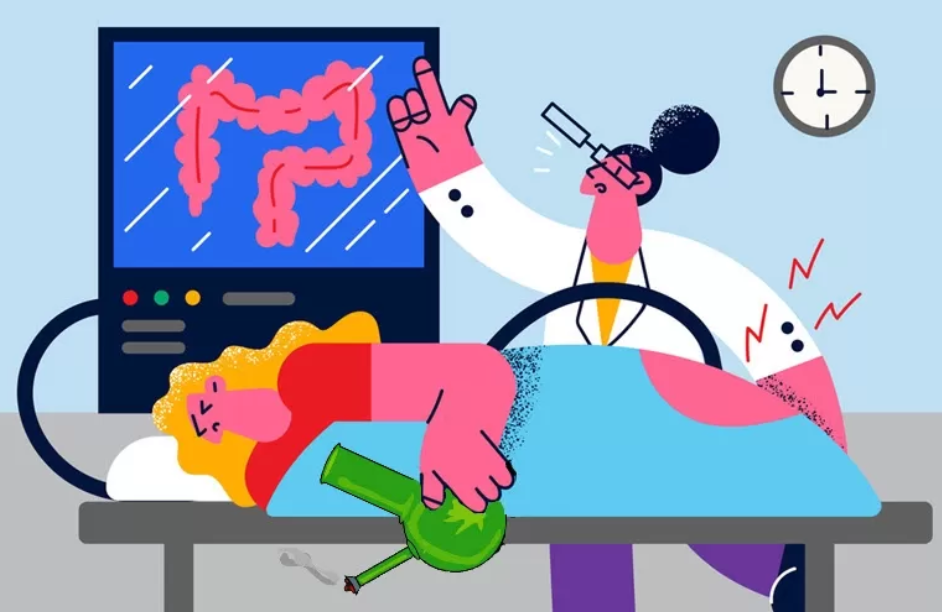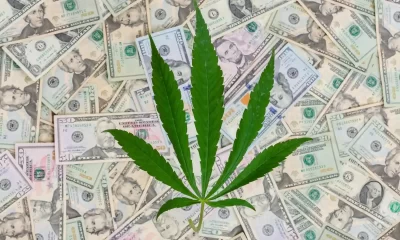Reports
What’s Your MAC Score? – Why Cannabis Users Need Stronger Sedation Drugs for Colonoscopies and Endoscopies

New study says marijuana users may need extra sedation during a colonoscopy or endoscopy
Endoscopies are a type of nonsurgical medical procedure that involves inserting an endoscope into the throat and down into the esophagus.
The tool, known as an endoscope, is used to examine the digestive system with a camera that has been designed into it. Gastroenterologists or other specialists will use this procedure to determine if there are any illnesses that affect the stomach, esophagus, or the upper digestive system. In some cases, patients need to be sedated with anesthesia to perform an endoscopy especially if it’s a high-risk case, or if the patient is pregnant since inserting the scope may irritate the upper area of the gastrointestinal tract. This can cause a gag reflex and major discomfort in some people.
Now, a new study has found that cannabis users may require more anesthesia than usual if they have to undergo an endoscopy.
The study, which was presented during the Digestive Disease Week 2022, involved researchers analyzing 419 adult patients who were about to undergo an endoscopy in Canadian medical centers. The endoscopy was to be performed with conscious sedation wherein the patient and relaxed though partially conscious. All patients were also asked to fill in two surveys, one before the endoscopy regarding their cannabis consumption while the other was after, asking them questions about how aware and comfortable they were during the procedure.
The researchers found that marijuana use was associated with the chances of requiring more anesthesia, such as over 5mg of midazolam, more diphenhydramine, or over 100mcg of fentanyl.
“Patients didn’t have increased awareness or discomfort during procedures, but they did require more drugs,” explains the study’s lead author, Dr. Yasmin Nasser, during a press release by the American Gastroenterological Association.
Same Results As Older Studies
There have been several other studies proving that cannabis users require more anesthesia during surgical procedures, which is a note of caution for consumers.
One report from 2019, which was published in the Journal of the American Osteopathic Association, found that cannabis users may need as much as twice more the normal dosage. The researchers from Colorado analyzed the medical records belonging to 250 patients who underwent endoscopic procedures after 2012, which is when recreational marijuana was legalized in the state. They found that daily or weekly marijuana consumers needed 220% more propofol, 20% more midazolam, and 14% more fentanyl to get to the ideal sedative state for procedures including colonoscopies.
“Some of the sedative medications have dose-dependent side effects, meaning the higher the dose, the greater likelihood for problems,” said head researcher Mark Twardowski, DO. “That becomes particularly dangerous when suppressed respiratory function is a known side effect,” he added. Twardowski also acknowledged that marijuana has interactions with other drugs. “Cannabis has some metabolic effects we don’t understand and patients need to know that their cannabis use might make other medications less effective. We’re seeing some problematic trends anecdotally, and there is virtually no formal data to provide a sense of scale or suggest any evidence-based protocols,” he says.
The researchers also suggest that patient forms asking about their cannabis use is critical for medical professionals to get the information they need to identify the right patient care protocols. “Determining cannabis use before procedural sedation can be an important tool for planning patient care and assessing both medication needs and possible risks related to increased dosage requirements during endoscopic procedures,” they wrote.
Another preliminary study from 2020 revealed that cannabis users who needed to undergo surgical repair for a broken leg needed almost 60% more opioid painkillers each day as they recovered in the hospital.
“It’s similar to flying a plane. You have a takeoff section, and then you have your cruising section and then your landing. These in anesthesia are induction, maintenance and emergence,” explains Dr. Ian Holmen, resident anesthesiologist at the Colorado Anschutz Medical Campus and the study’s lead author. “We found that it’s not just in the induction phase of anesthesia that you need more anesthesia, but even during that cruising phase you need more inhaled anesthetic.”
Holmen and his team analyzed the medical records of 118 surgery patients who went in for a broken shin bone. Thirty of them admitted to cannabis use, though the frequency and quantity were unknown. Those patients reported more pain after surgery, requiring more opioid painkillers.
They also found that cannabis users who already have existing lung or heart problems can face serious risks while in operation based on the quantity of anesthesia that they need for surgery. “Sevoflurane has a very clear dose-dependent effect on blood pressure,” says Dr. David Dickerson, who sits as vice chairman of the American Society of Anesthesiologists (ASA). “The more sevoflurane you receive in the OR, the more a patient’s blood pressure drops. If you have heart problems or lung problems coming into the OR, it could be dangerous.”
Conclusion
It can be understandable that you feel worried or uncomfortable about sharing your marijuana consumption habits with your health care provider. However, as more states legalize the plant, more doctors are becoming knowledgeable about its use as well as benefits.
Disclosing your cannabis habit to your doctor is extremely important if you are taking prescription medications or may have to undergo endoscopy or any other kind of surgery. Even if your health questionnaire doesn’t ask about it, doing so can make a critical difference in the outcome of your surgery since more sedative use may lead to complications. Last but not least, it’s in your best interest to share your medical history including cannabis consumption.
Business
Pot Odor Does Not Justify Probable Cause for Vehicle Searches, Minnesota Court Affirms

The Minnesota Supreme Court affirmed that cannabis odor does not constitute probable cause to search a vehicle.
If Minnesota police search a vehicle solely based upon the smell of pot, they can’t justify searching a vehicle, even if there is evidence found of other alleged crimes. Even after appealing a lower court decision to suppress the evidence—twice—the Minnesota Supreme Court agreed, and the dismissal of his charges stands.
In a ruling filed regarding a case the State of Minnesota Court of Appeals on Sept. 13, the Minnesota Supreme Court affirmed that cannabis odor does not constitute probable cause to search a vehicle.
The case has been ongoing for two years. On July 5, 2021, just before 10 p.m., a Litchfield police officer stopped a car for an obscure local law: the light bar mounted on the vehicle’s grill had more auxiliary driving lights than are permitted under Minnesota law. The officer asked the driver, Adam Lloyd Torgerson, for his license and registration. Torgerson, his wife, and his child were present in the vehicle. The officer stated that he smelled pot and asked Torgerson if there was any reason for the odor, which he initially denied. But cops found a lot more than just pot.
A backup officer was called in. The couple denied possessing any pot, but Torgerson admitted to smoking weed in the past. The second officer stated that the weed odor gave them probable cause to search the vehicle and ordered them to exit the vehicle. The first officer searched the vehicle and found a film canister, three pipes, and a small plastic bag in the center console. The plastic bag contained a white powder and the film canister contained meth, which was confirmed in a field test.
Torgenson was charged with possession of meth pipe in the presence of a minor and fifth-degree possession of a controlled substance after the unwarranted search of Torgerson’s vehicle.
Police Aren’t Allowed to Do That, Multiple Courts Rule
But the search had one major problem—cops weren’t searching for a meth pipe. They only searched his car because they could smell pot, and the meth and paraphernalia were a surprise for everyone. Still, they had no grounds to search the vehicle. The man’s charges were later dismissed after the district court determined the odor of cannabis alone was insufficient basis for probable cause to search the vehicle, regardless of whatever other drug paraphernalia they found.
The state appealed the case, but the Minnesota Court of Appeals affirmed the district court’s decision. The case was appealed a second time, this time to the Minnesota Supreme Court, which agreed with the lower court’s ruling.
“This search was justified only by the odor of marijuana emanating from the vehicle,” the Minnesota Supreme Court decision reads. “Torgerson moved to suppress the evidence found during the search, arguing that the odor of marijuana, alone, is insufficient to create the requisite probable cause to search a vehicle under the automobile exception to the warrant requirement. The district court granted Torgerson’s motion, suppressed the evidence, and dismissed the complaint. The State appealed. The court of appeals affirmed the district court’s suppression order. Because we conclude that the odor of marijuana emanating from a vehicle, alone, is insufficient to create the requisite probable cause to search a vehicle under the automobile exception to the warrant requirement, we affirm.”
It amounts to basic human rights that apply—regardless of whether or not a person is addicted to drugs.
Other States do Precisely the Same Regarding Pot Odor as Probably Cause
An Illinois judge ruled in 2021 that the odor of cannabis is not sufficient grounds for police to search a vehicle without a warrant during a traffic stop.
Daniel J. Dalton, Associate Judge of the 14th Judicial Circuit, issued a ruling in response to a motion to suppress evidence in the case of Vincent Molina, a medical cannabis patient arrested for cannabis possession last year.
In that case, Molina was arrested despite the decriminalization of small amounts of cannabis in Illinois in 2019 with the passage of the Illinois Cannabis Regulation and Tax Act.
In some states, the issue of probable cause and cannabis was defined through bills.
Last April, the Maryland House of Delegates approved a bill that reduces the penalties for public cannabis consumption and bars police from using the odor of cannabis as the basis for the search of an individual or auto. Under Maryland’s House Bill 1071, law enforcement officers would be prohibited from using the odor of raw or burnt cannabis as probable cause to search a person or vehicle.
The rulings represent the rights of citizens when they are pulled over by police, even if there are hard drugs involved.
Business
Legal Marijuana Handed A Nothing Burger From NY State

Following the chaos of the recreational weed rollout, the government is trying to figure out next steps. But it seems legal marijuana has been handed a nothing burger from NY state with their last rollout for potential cannabis retailers.. With an estimated $3.5 billion in sales at stake along with tax revenue for the state’s every growing budget, the fumble is costly for a significant number of players. And it has been a huge loss for the marijuana industry as a whole.
What was quickly seen as an opportunity was pounced on in the city with the most billionaires globally along with endless big and small entrepreneurs, and hustlers. Seeing a huge amount of cash on the table, players acted in a quickly in a way bureaucrats will never understand.
Embracing a Wild West approach, officials decriminalizated and fumbled licensed legalization of sales. Despite promises and initial outlines where existing medical marijuana dispensaries could switch to recreational and a fair, for government quick liscnese process, the state tossed it all in one stroke. In a vision of equity, officials decided to reserve the first retail licenses for felons and other “justice-involved” individuals. Lawsuits started, the desired licensees struggled to raise capital and over 1,600 unlicensed retail stores opened in NYC. For the small time players, they have set sidewalk card tables parks, selling roll-ups and handmade marijuana edibles, in full view of the police.
The updated systems was rolled out, but has left people confused, dispirited, and disappointed. The Office of Cannabis Management rolled out the previous Conditional Adult-Use Retail Dispensaries (CAURD) program with high hopes. Now, regulators voted to allow the state’s medical marijuana operators to apply for adult-use retail licenses. Multistate operators who have patiently acquired a majority of the state’s 10 registered organization.
“It was more like an orgy of minimalism. While they are getting ready to open the application window on October 4th (notably, originally it wasn’t intended to be a 60-day window, but rolling applications) for most license types (sans on-site consumption and delivery), they refused to address the CAURD program. Other than to suggest that it remains “a priority”, they have offered only some subtle hints in the guidance to the regulations. These include establishing a priority for retail applications which include secured real estate, which will be given priority after the initial 30-days of the 60-day application window have passed (although they do not define what that means). And noting that existing licensees may apply for an additional license so long as they comply with the rules of a two-tier system. The positive news is that these statements can be interpreted as an invitation to current CAURD licensees, many of whom will also meet other Social and Economic Equity (SEE) criteria entitling them to an additional priority.” shares Andrew Cooper, partner at Falcon Rappaport & Berkman LLP, one of the top cannabis law firms.
Unfortunately, there are multiple losers in the state’s unique approach. One is consumer and medical marijuana patients, including veterans. The unlicensed dispensaries are making a mint and overcharging customers due to high demand. Small investors and companies, including those who could be a player in the CAURD, will not have the financial to compete with multi-state and large players. And taxpayers will lose out for years to come as revue it lost to unlicensed dispensaries.
The good news, consumers will continue to find products easily over the next few years. There is even a thriving unlicensed dispensary a few blocks from City Hall.
While New York is awash with billionaires, fashion, food and smarts, common sense seems to be lack for making a good government plan.
Source: https://thefreshtoast.com/cannabis/legal-marijuana-handed-a-nothing-burger-from-ny-state/
Healthcare
This Activity Helps Those With Depression And Anxiety

A new study shows that exercise is extremely helpful for people coping with a mental health condition, affecting them more than people who don’t share these struggles.
One of the activities that people first recommend when discussing conditions like depression and anxiety is exercise. The suggestion is so pervasive that it’s almost a cliche by now. Still, evidence shows that exercise is incredibly helpful for your mental health, decreasing muscle tension, promoting the production of serotonin, and more.
A British study suggests that people with depression and anxiety are twice as likely to reap the benefits of exercise when compared to people who don’t suffer from these conditions.
The data was obtained by tracking the exercise patterns of over 50,000 people in their late fifties. About a third of them were affected by health conditions like depression and anxiety. While everyone experienced benefits from moderate amounts of exercise, people who had a mental health condition experienced 22 percent less risk of having a heart attack or a blocked coronary artery. For reference purposes, the majority of candidates only experienced a 17 percent decrease in their odds of suffering from a cardiac condition.
“The effect of physical activity on the brain’s stress response may be particularly relevant in those with stress-related psychiatric conditions. This is not to suggest that exercise is only effective in those with depression or anxiety, but we found that these patients seem to derive a greater cardiovascular benefit from physical activity,” said the lead researcher of the study, Hadil Zureigat.
Anxiety and other forms of stress can result in inflammation, a condition that creates risks for people’s circulatory systems. The effect of exercise targets different risk factors for people with an existing mental health condition, reducing the cortisol in their bodies and increasing cardiovascular health, all the while producing serotonin and boosting their moods.
Introducing a workout routine into your life when you don’t have one isn’t easy, but it’s often suggested to start off slow, taking your time to find an activity you find enjoyable. Just one exercise session can make you feel better, but the more you commit to it, the easier it gets to create a habit. Try working out with friends, outdoors, signing up to sports or classes — whatever keeps you accountable, and returning to your activity.
Source: https://thefreshtoast.com/news/this-activity-helps-those-with-depression-and-anxiety/
-

 Business2 years ago
Business2 years agoPot Odor Does Not Justify Probable Cause for Vehicle Searches, Minnesota Court Affirms
-

 Business2 years ago
Business2 years agoNew Mexico cannabis operator fined, loses license for alleged BioTrack fraud
-

 Business2 years ago
Business2 years agoAlabama to make another attempt Dec. 1 to award medical cannabis licenses
-

 Business2 years ago
Business2 years agoWashington State Pays Out $9.4 Million in Refunds Relating to Drug Convictions
-

 Business2 years ago
Business2 years agoMarijuana companies suing US attorney general in federal prohibition challenge
-

 Business2 years ago
Business2 years agoLegal Marijuana Handed A Nothing Burger From NY State
-

 Business2 years ago
Business2 years agoCan Cannabis Help Seasonal Depression
-

 Blogs2 years ago
Blogs2 years agoCannabis Art Is Flourishing On Etsy









